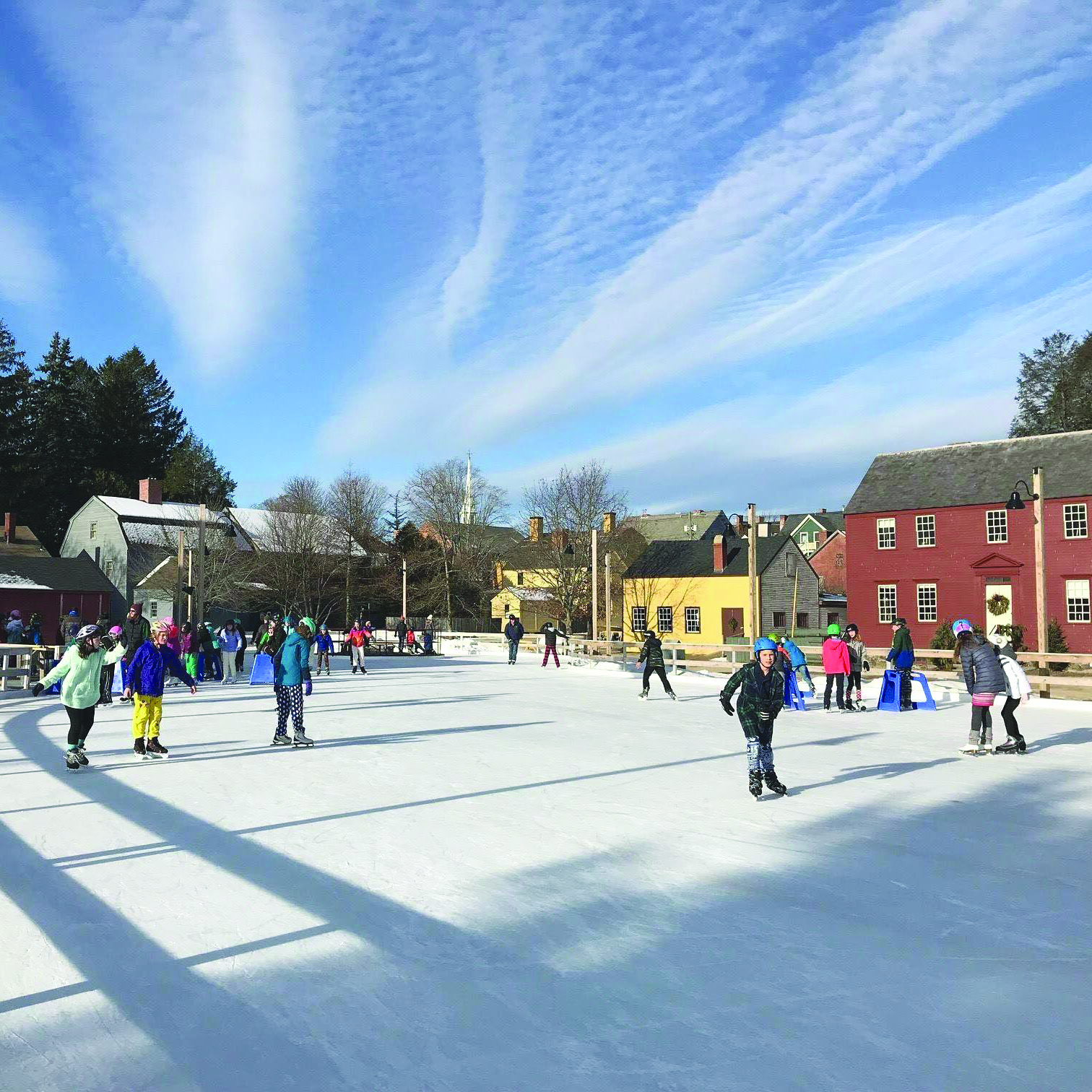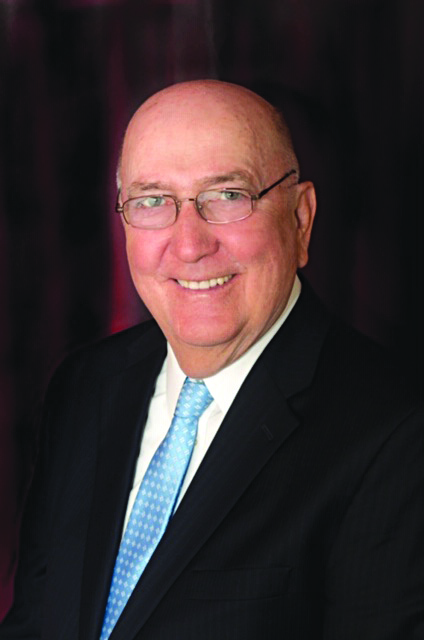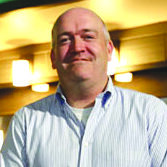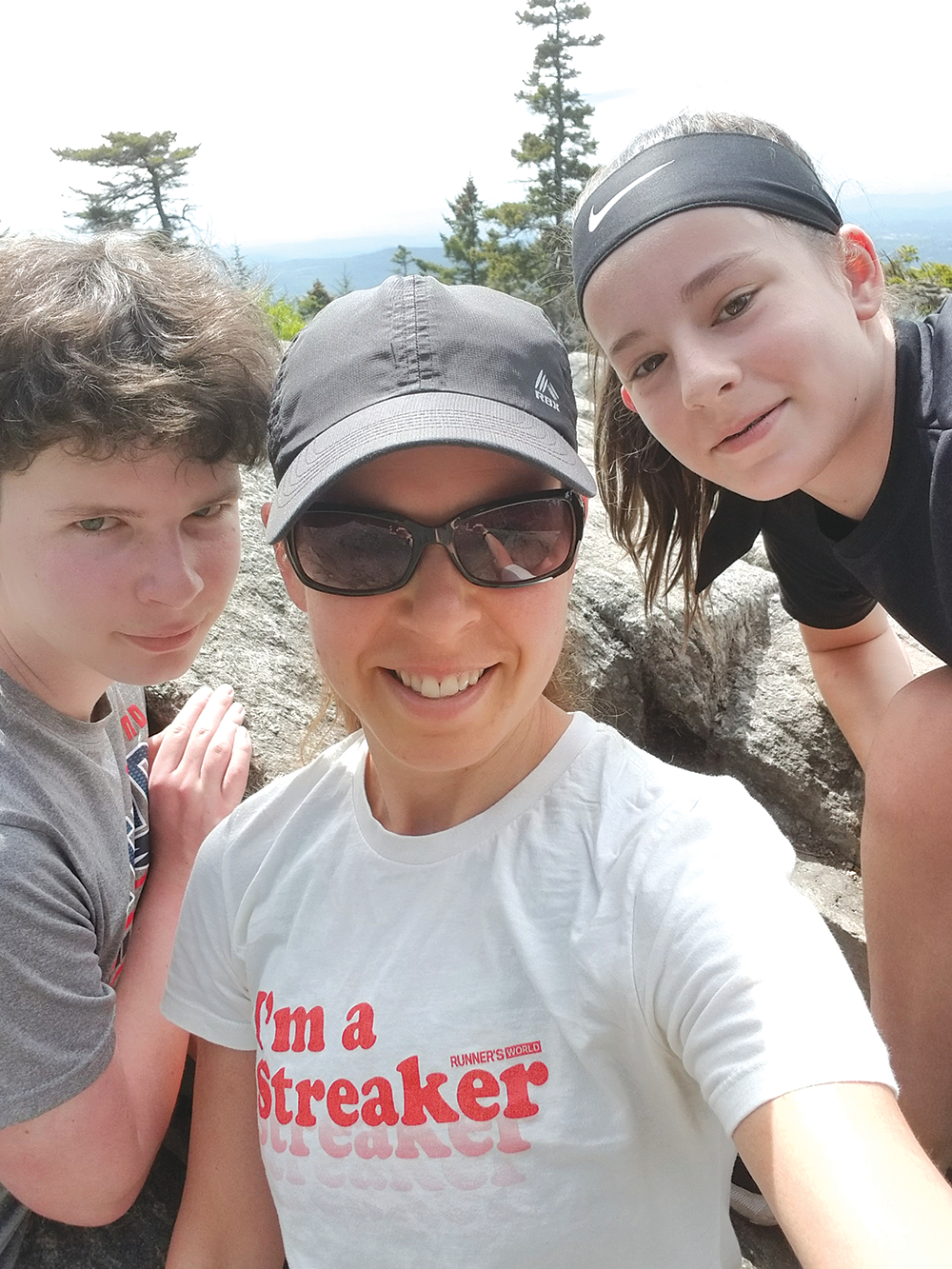How to challenge yourself to get going, stay at it and get in a race — even now
Two years ago, I got my dad a shirt that says “I’m a streaker,” and he gets endless enjoyment out of allowing strangers to think he is in the habit of taking off his clothes and running naked in public. In reality, it’s a Runner’s World shirt created for crazy people like my dad who have (fully clothed) running streaks of days, months or years.
You don’t have to run every day, or far, or quickly, to reap the benefits of running. Find out how and why to get off the couch, why streaks are, in fact, awesome (should you choose to go that route), and why running a virtual race is a great way to alleviate the fear of the starting line.
Just do it
One of the best things about running is how easy it is to get started, no matter what your fitness level is, how much time or money you have — or how much you dread the thought of being seen by your neighbors as you struggle, red-faced and sweaty, around the block.
Millennium Running owner John Mortimer watched his mom become a runner, starting by walking one mile a day — and only at night.
“She would put her reflective vest on in the cover of darkness and walk the mile,” Mortimer said.
She then started adding jogging intervals, going from one mailbox to the next while jogging, then walking to the next, and so on. She worked her way up to three laps — three miles — and then ran her first 5K.
“You can take baby steps,” Mortimer said. “It’s literally just about trying to move a little bit each day.”
Christine Lewis, co-owner of Total Image Running with business partner Lisa Misiaszek, has similar stories; she’s been training runners for more than two decades. She remembers training a friend, Lisa Trisciani, who had lost 100 pounds and set a goal to run the Disney half marathon. But she had never run before and was afraid to take that first step because she thought people would judge her. Lewis worked with her on walk/jog intervals as well as strength, core and balance training.
“Within eight weeks Lisa ran her first 5K,” Lewis said. “We continued to train and she ran the Disney half and crushed it.”
Trisciani has since run several full marathons, relay events and half marathons.
“You’re never too young, too old or too out of shape to start running,” Lewis said.
Gear up
“The best part about running is you don’t need a gym membership or fancy, expensive equipment to begin,” Lewis said. “Just get yourself a good pair of running sneakers and step out your front door.”
She recommends getting fitted for running shoes at a specialty running store such as Runner’s Alley.
The Millenium Running retail store in Bedford can help you find the right shoes too, taking you through a full fit process that includes gait analysis.
Running too much in the wrong shoe can turn you off to the sport altogether, whether it’s because the shoes themselves are uncomfortable or because they cause aches and pains.
“I think runners or walkers often stop doing it because it starts to hurt,” Mortimer said.
Other gear might include reflective vests or headlamps for safety if you’re running in the dark.
But other than the right shoes, “There’s nothing overly critical that you need,” Mortimer said.
Start slow, but stick with it
Mortimer has three key suggestions to help people get in the right mindframe to start running. First, he says, is to find your motivation. Why do you want to start running? It could be to improve your heart health, to lose weight for a wedding or to change your lifestyle. Keeping that motivation in mind will help you commit to yourself mentally and emotionally.
Second, Mortimer says, is to be consistent; if you stop doing it after a week, you haven’t gained anything from the experience.
“But that doesn’t mean you have to run 10 miles every day,” he said.
Lewis agrees.
“The reason people get discouraged quickly is because they do too much too soon,” Lewis said. “Don’t plan to run the entire time. Start with very short jog/walk intervals, doing more walking than running at first. Do not be ashamed to walk. It’s all part of the process. Listen to your body and take a break when and if you need it.”
Similarly, Mortimer’s third guideline is to be patient. You’re not going to see results overnight — you won’t lose five pounds overnight, and you won’t be able to go from running zero miles a day to running three overnight.
Lewis also recommends cross training, doing things like strength training and yoga to keep your body strong and limber. Mixing it up and balancing your body will help you stick with it, too, she said.
“It will help keep you injury-free and [avoid becoming] bored of the same running routine day in, day out,” she said.
Find support
There are all kinds of running clubs in New Hampshire, including the Millenium Running Club, the Runner’s Alley Club, and the Total Image Running Run Walk Brew Social Club. Becoming part of a club helps you meet other runners who will offer support and motivation.
“Our club is not just about running,” Lewis said. “It’s about motivating each other to work out then celebrate with socializing and a brew.”
Most clubs welcome all fitness levels and abilities, so even if you hesitate to call yourself a runner, well, you are.
“If you’re putting one foot in front of the other, you’re part of the running family,” Mortimer said.
Start streaking
Streaking runs in my family (yes, the terrible pun was unavoidable). My dad’s longest was 9,056 days; my uncle’s was 10,328 days (that’s more than 27 years of running every. single. day.). My cousin made it just past 1,000 days. It took an operation for prostate cancer to end my dad’s streak, and knee surgery to end my uncle’s.
I’m not a professional runner, but I have joined the streaking club (I’ll hit 1,000 days Aug. 16, barring injury or heat stroke), which I would say makes me qualified enough to tell you why running streaks are good for your mind, body and soul, whether you’ve never run before or you’ve run marathons.
1. They’re motivating. A streak will get you out the door when nothing else will. It was 96 degrees the other day, and the humidity brought the “feels like” temp to well over 100. If I didn’t have a streak to maintain, I absolutely would not have laced up my Sauconys and headed out for a run. I would have continued sitting on the deck in the shade at my parents’ cottage on the lake, justifying to myself that it was definitely too hot to run.
When I started this streak, I had no goal in mind. My thought was that I’d just run every day until I had a good enough reason not to — and that hasn’t happened yet. Snowstorms, heat waves, being insanely busy — none of those are real excuses. Dress warmly and watch for plows, dress lightly and drink plenty of fluids, bring running shoes everywhere so you can run after dropping one kid off at soccer practice but before picking up the other kid at football — “I have to run” means you figure it out. Without a streak, a million excuses can get in your way.
2. They’re better for your body than a Netflix streak. Again, I’m not a professional, and many runners and doctors might cringe at the whole concept of a running streak — because rest days! — but I personally think the pros outweigh the risks. (Still, talk to a doctor before starting any serious fitness endeavor or if you have any preexisting conditions or concerns.)
Every body is different, and so far mine is holding up just fine. In fact, I would argue that I’m healthier now than ever before. When I started running in my early 30s, I couldn’t even finish a mile without walking. I’m not a natural athlete, and I spent the first 30+ years of my life doing very little in the way of exercise. Now, I generally feel better, I’m stronger, and all my vitals are fantastic. If I weren’t streaking, I would choose the couch more often than not.
Still, if you’re sick, achy, or just not feeling it, there’s no need to overexert yourself. The running community generally sees one mile a day as the minimum you need to keep your streak intact. It’s unlikely you will die while running or jogging one mile if you don’t have any medical issues. But, you know, bring your phone just in case.
3. They keep you sane. Perhaps even more importantly than the physical benefits, my streak has provided a no-excuses outlet to clear my mind and alleviate stress. It’s built-in self care; my kids are almost always my priority, but because of this streak, I sometimes choose running over their wants and needs (I know, the audacity). If I didn’t “have” to run every day, I probably would put them — or work, or laundry, or lawn mowing — first 99 percent of the time. Running is my outlet. It’s where I can clear my head or think things through. I don’t even listen to music. I like the silence, the sound of rain, the quiet when the roads are covered in snow and no one else is crazy enough to be out. Not every run is amazing, and sometimes all I want is for it to be over. But I have never, ever regretted going for a run.
4. They make memories! Having to run means I sometimes have to carve out time in creative ways, and I’ve had some great experiences come out of that. I once ran laps around a parking garage at the Fort Lauderdale airport during a layover. During a trip out west last summer that was jam-packed with sightseeing and driving, I ran along the Grand Canyon, at Yellowstone (while stuck in not-moving traffic for more than two hours due to a herd of buffalo crossing the road), on a trail at the Grand Tetons, in a parking lot at Mesa Verde, in four states at once at Four Corners, and, less glamorously, on random roads when my family stopped for food on long days of driving. One of my favorite runs ever was with my brother on a snowy Christmas Day that was otherwise not very festive. I’ve also run races with my dad, my brother and my kids, because why not get some swag and have some family fun when you have to run anyway?
5. Anyone can do it. Your streak can be whatever you want it to be — you make the rules. Run a little, run a lot, have an end goal in mind or just keep going until you can’t or don’t want to anymore. Some people do holiday streaks, from Thanksgiving to New Year’s Day. Some people start with 30 days. Just start and see what happens. That’s what I did — and now I’m the proud owner of my very own “I’m a streaker” shirt.
Race your way
Whether you’re just starting out or you’ve been running for years, races can provide motivation in the form of time goals, finishing goals and community support — and the swag doesn’t hurt either.
Of course, the racing landscape looks a little different right now. The cancellation of road races in the spring quickly led to a transition to virtual races. Many organizations that typically held 5Ks as fundraisers turned them into virtual runs, and companies like Millennium Running in Bedford and Total Image Running in Auburn, which organize runs throughout the state, did the same.
There are some benefits to virtual runs, including their flexibility — most races offer a range of days and times you can run, and you can typically run anywhere you want.
Virtual runs can minimize race jitters, too.
“The fear of the starting line, the fear of that first step, is sometimes mitigated by [running virtually],” said John Mortimer, owner of Millennium Running in Bedford.
Millennium reintroduced in-person runs several weeks ago with exclusive 5Ks, keeping them to 100 participants, with two races every Saturday. The runners start one at a time, every five or 10 seconds, to avoid crowds gathering at the starting line and bunching up on the course.
Participants are taking the changes in stride, Mortimer said.
“By and large I think our running community has been super positive,” he said.
Virtual runs
Here’s a list of upcoming virtual races that under normal circumstances would be held at various locations around southern New Hampshire this summer and fall. A few are offering the option of running virtually or in person. Many races benefit local organizations. Check event websites for up-to-date information.
• There’s still time to participate in the Total Image Running Virtual Race Series’ Christmas in July Virtual 5K, going on now through July 25. Prizes will be awarded to the first-place male and female finisher. Registration costs $30 and includes a print-at-home bib and a downloadable finishers certificate. The registration deadline is Saturday, July 25. Visit totalimagerunning.com.
• Goffstown’s Berry Classic Road Race is going on now through July 26. Participants must run a continuous five miles, which they can do on the five-mile loop around the Piscataquog River in Goffstown or at another location of their choosing. Registration costs $20 and closes on July 26 at noon. Visit runsignup.com/race/nh/goffstown/berryclassic.
• Swimming with a Mission presents Virtual Swim with a Mission. Participants can swim, paddle or kayak any body of water now through July 31. There are 1K, 5K and 10K options. Registration is free and closes on July 24. Visit runreg.com/swim-with-a-mission-virtual.
• The Colon Cancer Coalition presents Get Your Rear in Gear virtually. To participate, do a physical activity of your choosing between now and Saturday, Sept. 12, then join the virtual event on Facebook on Sept. 12 at 9 a.m. Registration is free. Visit donate.coloncancercoalition.org/newhampshire.
• The Fox Point Sunset 5 Mile Virtual Road Race is open now through Saturday, Sept. 12. Run, walk or bike a five-mile course anywhere. Registration costs $10. Visit foxpoint5miler.org.
• The Total Image Running Virtual Race Series presents the Hula Hustle Virtual 5K & 10K from July 26 through Aug. 9. Register by July 24. The cost is $30 for the 5K and $35 for the 10K and includes a race T-shirt, a print-at-home bib and a downloadable finishers certificate. Visit totalimagerunning.com.
• The Cigna/Elliot Corporate Virtual Challenge & 5K will be held July 27 through Aug. 23 and is open to corporate teams and individuals. Participants are challenged to run or walk every day to train for the virtual 5K, which they can complete between Aug. 20 and Aug. 23. Registration costs $25 per person and includes a race bib and race mask. The registration deadline is Friday, Aug. 14, at 9 a.m. Visit runreg.com/cigna-elliot-5k.
• Granite Ledges of Concord’s Race to the Ledges 5K Run/Walk will be held virtually from July 31 through Aug. 9. The deadline to register is Aug. 7. Registration costs $20 now through Aug. 5 and $25 on Aug. 6 and Aug. 7. Visit genesishcc.com/gl5k.
• The Alton NH Old Home Week Virtual 5K will take place Aug. 8 through Aug. 16. Registration costs $15 and closes on Aug. 16 at noon. Visit runsignup.com/race/nh/altonbay/oldhomeweekvirtual5k.
• Lamprey Health Care’s Annual 5K Road Race will be held virtually from Aug. 8 through Aug. 16. Registration costs $25 and closes on Aug. 16. Visit runsignup.com/race/nh/anywhere/lampreyhealthcaresvirtual5k.
• You can do the Wine Run 4 Miler in person in Auburn, or you can do it virtually as part of the Total Image Running Virtual Race Series. The race takes place on Thursday, Aug. 13. Registration for the virtual race costs $35 and includes a race T-shirt or tank top, a print-at-home bib and a downloadable finishers certificate. Registration is limited to 300 participants, so register soon. Visit totalimagerunning.com.
• The Saunders at Rye Harbor 5K will take place virtually from Aug. 13 through Aug. 20. Participants can do a run or a competitive walk. The deadline to register is Wednesday, Aug. 19, at noon. Registration costs $30 and includes a race T-shirt. This race is a part of the Seacoast Road Race Series. Visit saunders10k.com.
• The Sabine Strong 3.3 will be held virtually on Sunday, Aug. 30. Registration costs $35 and closes on Wednesday, Aug. 12, at noon. Visit runsignup.com/race/nh/newington/sabinestrong33kidsdash.
• The Marcus Warner Memorial 5K Race will take place virtually on Saturday, Sept. 5, and Sunday, Sept. 6. Registration costs $10 and closes on Sept. 5 at noon. Visit marcuswarner7.wixsite.com/marcuswarner5k.
• Veterans Count presents the Wolfeboro Pirates Cove 5K Fun Run & Walk from Saturday, Sept. 5, through Monday, Sept. 7. Registration costs $25 for runners and walkers age 13 and up and $15 for service members, veterans and children age 12 and under and includes a printable bib and finishers certificate. The registration deadline is Friday, Sept. 4, at noon. Register by Aug. 12 to receive a free long-sleeved race T-shirt. Visit runreg.com/wolfeboro-pirates-cove-5k.
• Join the 12th annual Celebrate Pink 5K Run & Walk virtually between Monday, Sept. 7, and Sunday, Sept. 13. Registration costs $30 for adults and $20 for youth under age 14 and closes on Sept. 13, at noon. Register by Aug. 14 to receive a free race T-shirt. Visit cp5k.mybreastcancersupport.org.
• The Hunger is the Pitts 5K will be held on Thursday, Sept. 17, in person in Auburn and virtually as part of the Total Image Running Virtual Race Series. Registration for the virtual race costs $30 and includes a race T-shirt or tank top, a print-at-home bib and a downloadable finishers certificate. The registration deadline is Wednesday, Sept. 16. Visit totalimagerunning.com/hungeristhepitts.
• The 15th annual CHaD HERO will be held virtually from Oct. 4 to Oct. 18. Participants can run, walk, hike or bike, or they can complete their own “Virtual Quest” activity like hiking the Appalachian Trail or racing across the state. A virtual celebration with live music, special guests, raffle prizes and more will take place on Sunday, Oct. 18. Registration costs $15; register by Oct. 17. Visit chadhero.org.
• You can walk or run the Great Island 5K in person in New Castle or virtually on Sunday, Oct. 11. Registration costs $25 and closes on Oct. 10 at noon. This race is part of the Seacoast Road Race Series. Visit greatisland5k.org.
• The TangerFIT Virtual 5K takes place Oct. 11 through Oct. 18. Registration costs $25 for participants age 16 and up $15 for youth age 15 and under and closes on Friday, Oct. 2, at noon. Visit tangeroutlet.com/race.
• The Animal Rescue League of New Hampshire presents its Howl-O-Ween 5K virtually from Thursday, Oct. 15, through Sunday, Oct. 18, with a finish line celebration on Facebook Live on Oct. 18 at 11 a.m. Registration costs $30 for participants age 13 and up, $20 for youth age 12 and under and an extra $5 to include your dog as an official participant. The registration deadline is Friday, Oct. 16, at noon. Electronic bibs will be emailed to participants the week of the race. Register by Sept. 12 to receive a free race T-shirt. Visit rescueleague.org/howloween5k.
• The Pumpkin Regatta 10K takes place on Sunday, Oct. 18, in person in Goffstown and virtually as part of the Total Image Running Virtual Race Series. Registration for the virtual race costs $35 and includes a race T-shirt, a print-at-home bib, a training plan and a downloadable finishers certificate. The registration deadline is Saturday, Oct. 17. Visit totalimagerunning.com/pumpkinregatta.
• The Seacoast Half Marathon is going virtual. Participants can do a 5K, quarter-marathon (6.55 miles) or half-marathon anywhere, any day between Oct. 31 and Nov. 8. Standard registration costs $15. Registration for the 5K or quarter-marathon that includes a long-sleeve race T-shirt costs $35, and registration for the half-marathon that includes a long-sleeve race T-shirt and finishers medal costs $40. Registration closes on Saturday, Oct. 31 at noon. Visit seacoasthalfmarathon.com.
• Veterans Count, an Easterseals program, presents Penmen for Patriots Virtual 5K from Nov. 1 through Nov. 30. Registration costs $30 and includes a race bib and long-sleeve T-shirt. The registration deadline is Monday, Nov. 30, at 7 p.m. Visit vetscount.org/nh/events/penmen-patriots-5k.
Photo: Meghan Siegler proudly wears her “I’m a streaker” shirt on a (slow, walking) hike with her kids, Ben and Eisley, who have been very supportive of her streak despite constantly hearing things like “I’ll be back in time for the second inning” and “We can’t — I still have to run.”










